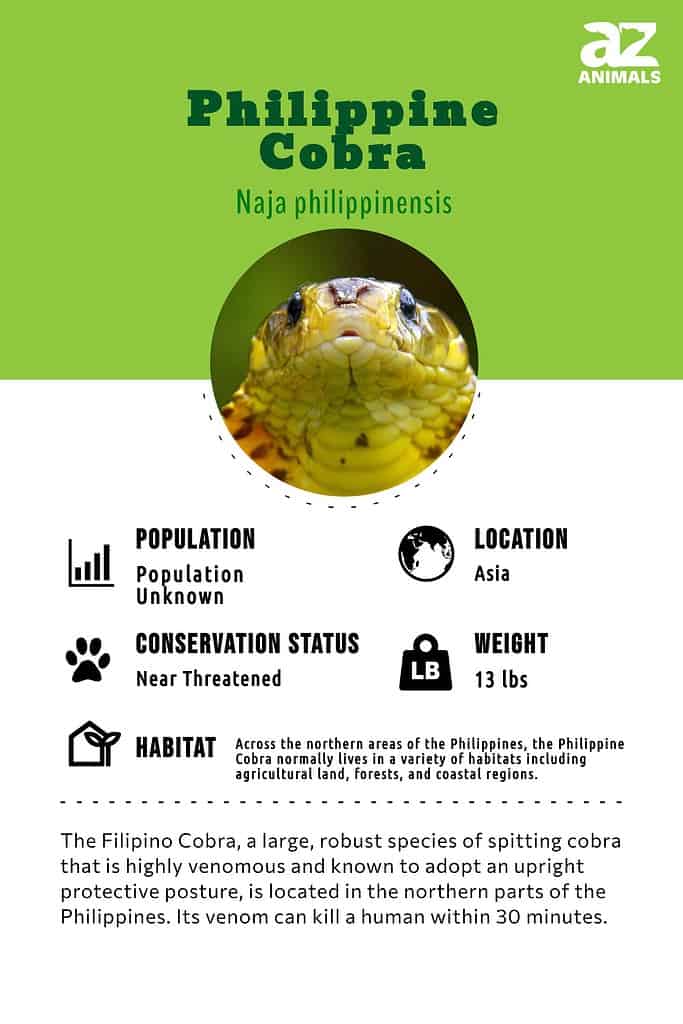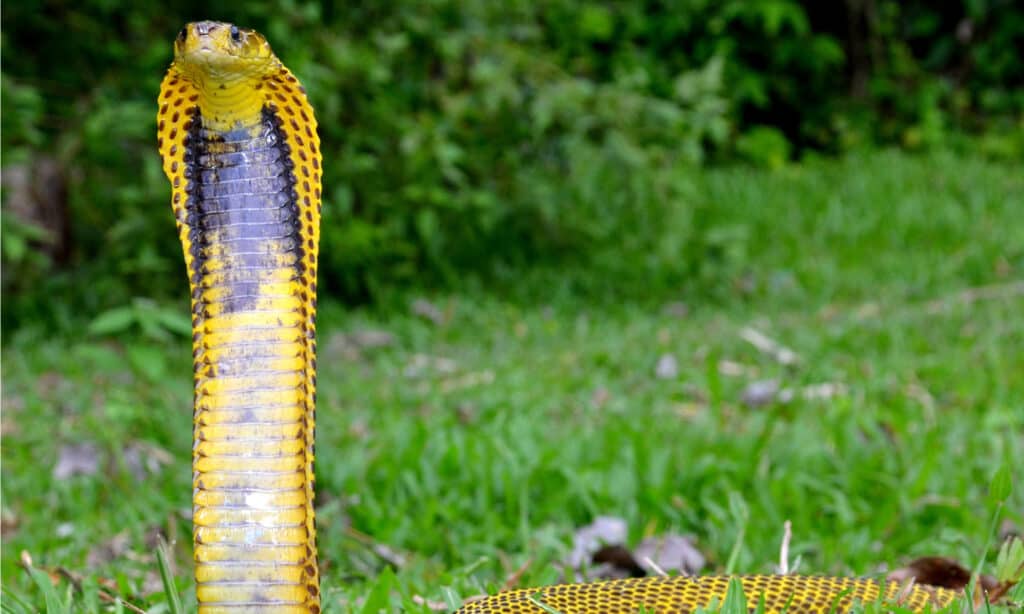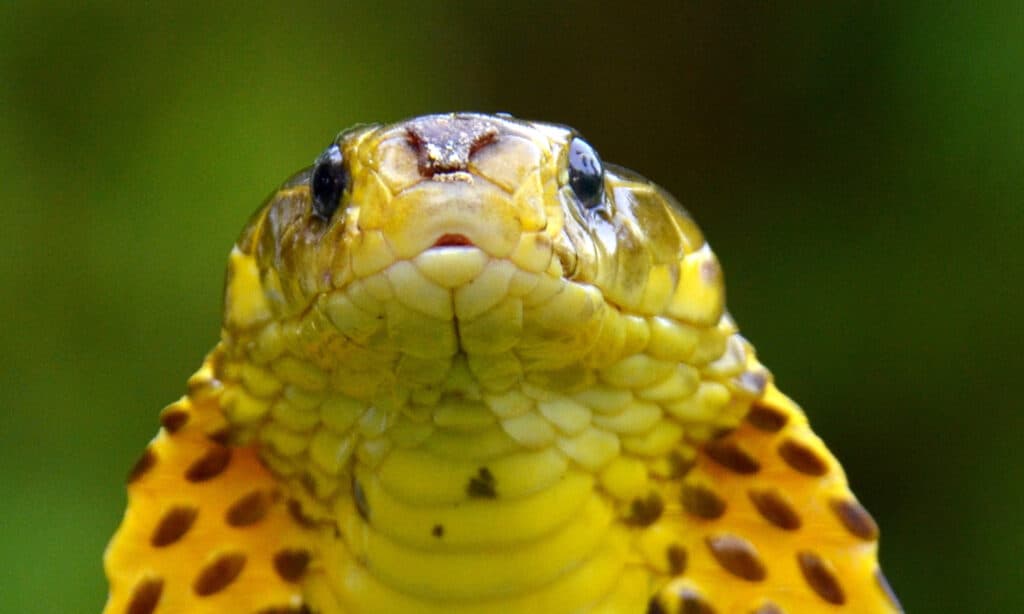Philippine Cobra (original) (raw)

The Philippine cobra, also known as the northern Philippine cobra or the spitting Philippine cobra, is exclusively found in the Philippine islands.
They usually range from 3 to 5 feet long, depending on the particular snake. They don’t need support from their mother after they are born, even though the baby snakelet is no more than 20 inches long in size.
Though the name often refers to the northern Philippine cobra or the spitting cobra, you might also see the southern Philippine cobra, which is bright yellow and black.
5 Amazing Philippine Cobra Facts
- The typical diet of the Philippine cobra consists of small mammals, frogs, other snakes, rodents, and more. However, they are often animals of opportunity in their diet, which means that they will also eat small birds and eggs when they can reach them.
- Even though this cobra is quite a predator in its own right, it isn’t safe from other predators like humans, birds of prey, mongooses, and king cobras. Even though large rats won’t necessarily eat these snakes, they’ll bite and fight back.
- To blend in with their surroundings, the color of the Philippine cobra’s body is light brown, though the blotches along the body are dark brown in color.
- The closely related southern Philippine cobra is much bolder in color with yellow and black as the main colors. It is also highly venomous.
- Baby Philippine cobras are called snakelets. The baby snakelets don’t require any care from their mother.
Where To Find Them
If you’re looking to find the Philippine cobra, there’s only one location to go – the Philippines. It is spread over multiple locations in the northern Philippines, including the islands of Luzon, Mindoro, Catanduanes, and Masbate. There’s a chance that other islands nearby might have these snakes as well, but there aren’t any confirmed cases.
The primary habitat of the majority of these snakes tends to be forested locations and low-lying plains. However, they can also be found in grasslands, jungles, and open fields.
Though they do not like to be approached by humans, they won’t even shy away from human settlements if their diet leads them there. They especially love water, so they can also be found near rivers, ponds, and other areas.
Evolution and Origins
The Philippine cobra (Naja philippinensis), also known as the northern Philippine cobra, is a stout and extremely venomous type of spitting cobra found in the northern territories of the Philippines. The Tagalog term for the Philippine cobra is ulupong, while it is referred to as carasaen in Ilocano and agawason in Cebuano-Bisaya.
In general, Cobras inhabit the regions from southern Africa to southern Asia, as well as the islands of Southeast Asia. In various parts of their range, certain species are popular with snake charmers, who scare them into displaying an upright defensive stance.
Furthermore, the Philippine cobra is an extremely hazardous and venomous species. It is one of the rare 14 types of cobras that are known to spit at their attackers. Studies indicate that this snake is among the most poisonous ones worldwide, and its venom can cause fatality in humans within a mere 30-minute timeframe.
Different Types
- Indian cobra
- Javan spitting cobra
- Monocled cobra
- Egyptian cobra
- Black-necked spitting cobra
- Cape cobra
- Chinese cobra
- Indochinese spitting cobra
- Forest cobra
- Red spitting cobra
- Mozambique spitting cobra
- Snouted cobra
- Samar cobra
- Central Asian cobra
- Zebra snake
- Mali cobra
- Andaman cobra
- Many-banded snake
- Dwarf water cobra
Scientific Name
The Philippine cobra sometimes called the spitting Philippine cobra or the northern Philippine cobra, has the scientific name Naja philippinensis. In Tagalog, this cobra is called ulupong, though it is also called agwáson (Cebuano), banákon (Cebuano), or carasaen (Ilocano). The name was originally used by Edward Harrison Taylor, an American herpetologist from 1922, and it is Latin for “cobra from the Philippine Islands.”
Its class is Reptilia, and it belongs to the Elapidae family. Its phylum is Chordata.
Population and Conservation Status
The worldwide population of Philippine cobras is one of the many unknown facts about the species. However, according to the IUCN, this cobra is Near Threatened, and their species is decreasing steadily.
Appearance and Description

Samar cobra, is a snake similar to the Philippine Cobra. The Philippine Cobra has a light brown body, decorated with dark brown blotches all over.
©ccarbill/Shutterstock.com
Ranging from 3.3 feet to over 5 feet long in size, the spitting Philippine cobra is a medium-sized snake. With a subtle change from the head to the neck, it has dark brown round eyes, and it is rather stocky. The body is light brown in color, decorated with dark brown blotches all over. This is much different than the southern Philippine cobra, which is bright yellow and black.
How to identify Philippine cobras:
- Up to 5 feet long in total size.
- Light brown body with dark brown blotches.
- Slimmer neck with broader head.
Venom: How Dangerous Are They?

Samar cobra, Naja samarensis, an endemic cobra from Philippines. This is a snake similar to the Philippine Cobra. The Philippine Cobra has dark brown round eyes, and it is rather stocky.
©ccarbill/Shutterstock.com
Part of the reason that the Philippine cobra is so dangerous is the venom that it releases. This venom can impact your respiratory function, causing paralysis as it stops the nerve signals from getting to the muscles. The venom is exclusively a neurotoxin, but you don’t have to even be bitten to suffer the consequences. This cobra is capable of spitting their venom nearly 10 feet away.
If a Philippine Cobra bites you, you’ll quickly feel nausea, start to vomit, experience pain, and more. It is important to seek out medical attention quickly because not being treated could lead to death as quickly as 30 minutes after the bite. Even though the actual risk of fatality depends on the particular snake, you need to seek medical attention as soon as the bite happens.
Behavior and Humans
Due to their highly toxic venom, Philippine cobras are dangerous to humans, but they don’t go out of the way to be aggressive. They only become aggressive with humans if they are provoked by threats or by being handled. They are not friendly, and they should not be kept as pets.
Similar Animals
View all 229 animals that start with P
These snakes are primarily active during the day for hunting, tasting the air with their tongue to locate potential prey.
This cobra bites, releasing enough venom to kill up to 20 in one dose.
Based on toxicology studies, it has some of the strongest venoms among any cobra species.
Absolutely. It is one of the most venomous cobras of the Chordata phylum in the world.
The Philippine cobra is very dangerous and venomous. In fact, it is one of only 14 cobra species that will even seemingly spit at their threats. Research shows that this snake is one of the most venomous in the world, and the venom could lead to human death within just 30 mins.
As the name suggests, this cobra is primarily found in the Philippines in Luzon, Mindoro, Catanduanes, and Masbate.
The typical diet of this cobra consists of small mammals, frogs, and other snakes. The easiest prey for them to capture and eat are rodents, though they’ll even eat eggs of other animals.